|
FAQs about Stony Coral, Cnidarian
Identification 2
Related FAQs: Stony Coral ID 1,
Stony Coral ID
3, Stony
Coral ID 4, Stony Coral ID 5,
Stony Coral ID 6, Stony Coral ID 7, Stony Coral ID 8, Stony Coral ID 9, Stony Coral ID 10, Stony Coral ID 12, Stony Coral ID 13, Stony Coral ID 14, Stony Coral ID 15, & Cnidarian
Identification, Stony FAQs 1, Stony
FAQs 2, Foods/Feeding/Nutrition, Disease/Health, Propagation, Coral Compatibility, Stony Coral Behavior,
Related Articles: Stony
Corals,
|
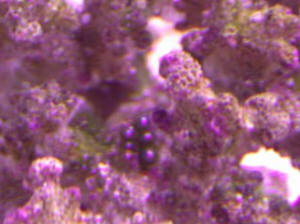
|
Coral ID 6/29/05 Hi, I have been trying to id this coral with
no luck. Any help would be greatly appreciated. Thx Jim _
http://i7.photobucket.com/albums/y251/negncic/DSCN0330.jpg_ (
http://i7.photobucket.com/albums/y251/negncic/DSCN0330.jpg)
<From what I can discern in the image... it appears to be a
Lobophyllia. Kindly, Anthony>
Turbinaria peltata Follow-up Dear Bob and Crew,
<Dean> I want to update you on the problem I was having with
my Turbinaria peltata. I am happy to report that the
tissue has stopped receding. It appears that the coral
is starting to take back some of the territory that it
lost. There was some apparent light shock after
upgrading of my lighting. But I believe that the upgrade
was a positive move. I went from 100 watts to 260 watts.
<!> Also, I have increased the number of times per week that
I target feed this coral. I am now feeding this coral at least
three times per week. Some weeks it gets target fed four
times per week. I believe all is good now. <Good>
I do have some additional of questions. I had a coral put on hold
for me at the LFS. I was told by the assistant, who
seems to be very knowledgeable, that it was a Yellow
Scroll Coral AKA Turbinaria reniformis. After some
research on your site, I came to the same conclusion. I
also decided that with my level of experience, and the steadily
improving conditions of my tank, this was a coral I could keep in
my system. However, I found some additional material on
your site that make me believe this identification my not be
correct. I was reviewing the section on "The Best
Corals for Your Reef System" and ran across the section on
Montipora Corals. Specifically the section of pictures
"More Montiporas in Aquariums" I now believe
what I have is a Montipora. Could you please review the
attached picture and give me your opinion. <This is
Turbinaria... not an Acroporid> I have a mushroom in my tank
that has grown to the point that it is touching my brain coral.
<Best to separate... ASAP> The brain is losing this
battle. My question is, can I take a pair of scissors
and trim off the offending edge of the mushroom without hurting the
mushroom. <Best to break it off and move, if you
can't just re-arrange the rock it is attached to... or move the
Brain...> It will be about one inch x 1/4" section that
will be removed. And, if I cut this section up into smaller pieces,
will these pieces grow into another mushroom. I dose my tank every
evening with Kalk for my make-up water. My drip
mechanism leaves about 1 1/2" of fluid in the bottom of the
container. Does this material need to be discarded every time or
can I add a little less Kalk and just add more water.
<Eventually has to be tossed, but not every time> Thanks for
your kind assistance and happy reefing. Dean
<Be chatting. Bob Fenner> |
|
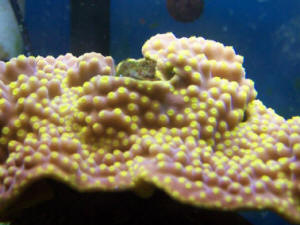
|
| What Coral? Hi Bob, I am hoping that you can help with
the identification of this coral. The hobbyist who has had a very
healthy colony for the last 10 years, insists that it is a
"brain coral". He also has a sister colony from it. I
have looked in several books but not found it. Thanks for your
help. All the best, Iggy <Mmm, a Mussid for sure, likely a
Lobophyllia species. Please see here: http://www.wetwebmedia.com/mussids2.htm Bob
Fenner> |
|
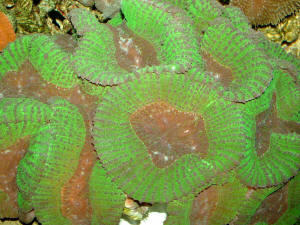
|
Coral ID 4/2/05 I saw this coral one time that is red, white
and blue striped and has a round shape at the bottom. I have seen it in
my marine aquarium screen saver also. I have no idea what it is called.
Do you know? Thanks - Joe <It's... dyed. RMF> <It sounds
very patriotic. Do visit your local aquarium store to browse through
Eric Borneman's Aquarium Corals... or seek photo galleries online
such as coralrealm.com
Anthony>
Goniopora & Yellow Cup Coral 4/1/05 I'm in a bit of a
bind. My parents surprised me with 2 gifts, Goniopora and what the
store told them, yellow cup coral. They picked it up while on a road
trip, and don't even remember the name of the store. I'm having
trouble finding out info. on the yellow cup, <It's tough to
say... it may be a dyed coral (Yellow Turbinaria peltata)... or it may
be one of the real yellow species like reniformis. Do look for pics of
Turbinaria species.> ...but was horrified with what I learned about
Goniopora. <Yes...> My parents thought they were doing a
good thing. Little did they know. Now, I'm stuck with these 2
corals that I know very little about. They have no idea what store they
bought it at, so there's no chance of returning these items. First
off, is there anything I can do to sustain my Goniopora other than
pray? <Actually... if it's a free-living green G.
stokesii, then keep it on a Deep Sand Bed and stir the sand around it a
couple times each week minimum> I've read a lot on your website,
and I normally never introduce coral unless I've thoroughly
researched it. But, now I'm stuck. The Gonio seems okay, it gets
bigger and bigger every day it seems. The yellow cup I have as high up
as I could put it in the tank, but the edges seem to be fading in color
, and there is a brownish lining around the tubes. Here are the
parameters of my 30 gall. Cube tank---ammonia btwn 0 and .25, nitrates
at about 20, nitrites at 0, alkalinity btwn 80 and 120 (though I
don't know how this element affects the tank), ph at 7.8. I've
got mushrooms, 2 open brains, polyps that seem to be turning white
(probably not a good sign), a yellow leather coral, and the 2 new
corals mentioned above, along with dozens of hermit crabs, snails, and
4 small fish. I feed the gang Cyclop-Eeze which everyone seems to love,
and DT's Phytoplankton. <Do consider adding DTs
"Natural Diet" to the mix here. Fabulous food!> I add
iodine, strontium/Molybdenum. once a week, and I was adding calcium
every few days, but I also use Oceanic salt which has a lot of calcium
in it. I need to buy a calcium tester this week, so I can't tell
you the calcium levels of my tank yet. I've got a Prizm skimmer,
huge wet/dry AMiracle filter and 176 combined wattage. I was doing 10
gall. water changes weekly until about 2 mos. ago, when I started doing
10 gall. water changes every 2 weeks instead. <Ughhh! Please
be more generous with the water changes> Can you give me any info.
on the yellow cup coral as far as feeding or otherwise, and is there
any hope for Goniopora? Thanks for your time, and sorry for this
lengthy email. <Best of luck! Anthony>
Pearl like things? I have these tiny blackish, bluish
round pearl like things on some my live rock and hard corals,
<< Well it looks like bubble algae. Hard to say
for sure, but I'm thinking Derbesia osterhoutii or Valonia
macrophysa. Either way it is good. >> the more I
look the more I find...attached is a few photos. Thanks
for your help. Photos are attached as well... 225 gallon salt live
rock,1 cleaner shrimp, 1 anemone, 1 emerald crab, snails, 2
starfish, purple tang, yellow tang, Naso, purple dwarf angel, 2
percula clowns, 4 striped damsels...PH and all levels check out
fine. I use a RO-DI water... Lou Montanaro
<< Blundell >> |
|

|
Strange polyp classification I own a marine tank and some
strange polyps started to grow on my heater about a month ago. I am
doing an honors bio project on them and want to classify them. I have
narrowed it down to either scyphozoa or anthozoa classes. Here are
their characteristics: 1.. white tube-like body with clear
mesophyl layer surrounding it 2.. central body cavity with
very fine tentacles surrounding the mouth of the cavity 3..
algae grows on them but they do not appear to be harmed 4..
about 1-1.5 cm long at most. Can be down to 2mm (appx.) 5..
sessile 6.. reproduction through budding Do you know what
they are? <Mmm, no... but do agree as to their being cnidarians most
likely> I have a friend with access to a lab and wish to section
one. Do you know proper sectioning protocol or what stains are best for
soft bodied invertebrate marine organisms? <In my day Hemolysin and
Eosin were the dyes of choice... soaking, relaxing cnidarians in
isotonic KCl (about 5% if memory serves) and then cooling to death (in
a refrigerator)... embedding in paraffin and sectioning (in a
microtome) at various thicknesses... Bob Fenner> Thank you for your
help. From, Brandon Pietras ><)))">
Polyp ID... hello, << Hi. >> Thank you for all of
your wonderful information. I have received a round ball of
polyps that is not attached to any rock. The person I
received them from said they are from the Caribbean << Are they
Blundell Buttons? Mostly a tan brown color about the size of
a quarter? >> and they are frequently found this
way. My question to you is, do I need to attach to rockwork
and if so how would I do this. << I'd put a rubber band
around the polyps to hold the whole colony onto a rock. Then
just see if they attach over time and grow to the
rock. I'd have a hard time believing that they don't
naturally grow on reef rockwork. >> Thank you, Jennifer.
<< Blundell >>
Please identify Hey guys, I just want to say
that I own Reef Invertebrates and I constantly use it when I am
selecting inverts for my aquarium. Also, your FAQ
sections have helped me through more problems than I can remember,
thanks for keeping up such an awesome forum and valuable collection
of information. >>Thanks!>> I recently
purchased what I believe to be some kind of Acanthastrea, possibly
a lord. It looks very similar to the toxic Acan on
www.berlinmethod.com However, I am not sure and have
been told it is a Favia instead. Can you please help me
on making a definitive ID on my coral?? Thank you very
much, the pic is in the attachment. >>Hard to tell, can you
get a pic when the polyps aren't extended, so we can get a look
at the skeleton?>> Beau Phillips
>>Rich>> |
|
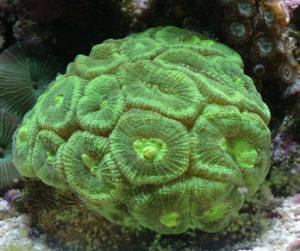
|
| Coral buds on rock ID 6/14/04 Hi guys- <hi-dee ho>
Can you guys tell what these critters are? <yep> The two
mushroomy things (center left and upper right) seem to me to be
some kind of corallimorpharian. There are four in the
tank. <interesting... you are close with he mushroomy vibe, but
these are stony mushroom corals (not corallimorpharians): Fungiids
polyps. Do a search for Fungia and you'll see some adults>
The coral(?) on the Astrea snail has been there for
weeks. Nothing seems to bother it as the snail
perambulates around the tank. <this specimen is too generic to
ID even to genus. It is a stony coral.. perhaps a Poritid (a common
hitchhiker), but tough to say untill it gets larger> Once again,
thanks for this amazing site! Malcolm Young 125 gal, 30 gal sump
with refugium, AquaC Urchin, 150# live rock, Purple Tang, Six-line
Wrasse, Randall's Goby, Percula pair with bubble tip, 7
Chromises, Sunrise Dottyback, small cleanup crew (6 hermits, ~20
snails, brittle star), 2 peppermint and one pistol shrimp. <keep
on reefin/rockin in the free world :) Anthony> |
|
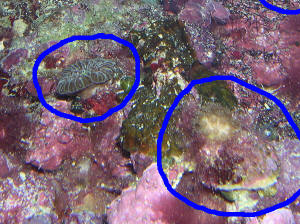
|
Coral ID For A Friend In Need! I'm trying to advise an
email acquaintance on the dismal selection of marine life that she
bought for her new/used 35 gallon dimly lit tank. <I can only
imagine!> She described one as a "nano" coral. Any ideas
what she could be referring to? I've heard of nano reef tanks and
Acropora Nano (which I hope it's not). Thanks, Suzanne <Well,
Suzanne, I can only wonder if the coral is an Acropora of some sort.
Without a description, we're just grasping at straws! Common names
are usually a dreadful way to identify a marine animal, as you know.
Just think of all the fishes known as "Blue Tangs" or
"Yellow Wrasses"...Any possibility that she can send you a
pic? Otherwise, do work on your psychic skills...Sorry I couldn't
be more helpful! Regards, Scott F>
Coral ID For A Friend In Need (Pt. 2) Thanks for your
response, Scott. <You're quite welcome! Sorry I couldn't be
more helpful in ID'ing the coral!> I'll work on the photo
angle if she ever answers my last email. I think I may have depressed
her when I told her that what she described as "strictly
beginner" was definitely NOT: 35 gallon tank with one white, one
pink, one blue normal fluorescent bulb, so she bought a rose anemone,
the mystery nano coral, a mushroom rock (fine!) and a "flower
pot". Oh, and of course, a Yellow Tang. Sigh. <Double
SIGH!!!> I told her to keep the mushrooms and try to get rid of the
rest. Do you know anybody in the Chattanooga TN area who might like a
nice Yellow Tang and some not-beginner corals? <I'll bet there
are a bunch of hobbyists out that way who would step up, and maybe even
trade for some easier-to-keep specimens!> Too bad people don't
realize how nice, easy and herbivorous Rabbitfish are in comparison to
Tangs. I won't even try to keep Tangs anymore since I discovered
Rabbit Fish! I even kept a Black, Yellow and Magnificent Foxface
together in one tank until I tired of seeing all three of them trying
to make tight turns all at once as they schooled happily around the
tank, like the Queen Elizabeth in a bath tub. <Yep.. They can get
pretty large; one of the only real downsides to keeping them. And,, of
course, caution must be paid to their venomous spines> And not one
case of Ich the whole time I had them. Suzanne <Thanks for being a
good friend, Suzanne! The hobby needs more helpful friends like you!
Regards, Scott F>
Identifying of bubble coral! Hi Tim again,
I got this bubble coral. I was told it was a cay-eye bubble coral
from the LFS. Is this correct or what's your ID on it?
<There are many common names for corals; I personally find these
common names misleading. I can think of several common names to
describe one bubble coral (Such as pearl bubble coral, Bladder
coral, Bubble coral, etc.). If you wanted the proper name for the
coral, it would be Plerogyra sinuosa (Otherwise known as the Bubble
coral, Bladder coral, Cay-Eye bubble coral, etc.) Thanks.
<No problem. Take Care, Graham.>
Cheers,
Ben |
|
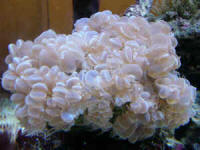
|
| Atlantic corals ID 2/17/04 Hi,
Bob or whoever answers now. <Anthony Calfo in your service>
Thank You very much for Your I.D. of the anemone. I also received
some rock fragments with live corals on them. Could You i.d. them
for me. They were collected on the same Cayo in shallow water,
3' here in the Caribbean. There are 3 corals. The finger coral
in the front, the yellow cone like coral in the middle and the
light brown one far in the back on a rock that has 2 more on them.
My photos are not so good, that's why I send You several of the
same corals for better id. Sorry to rob you of your valuable time.
<no worries... its an easy ID too: looking at the last photo
(file name MVC-002S), the finger coral is a hydrocoral - the
dreaded Millepora Fire Coral... the yellow stony is "Mustard
Hill" Porites (astreoides)... and the brown coral looks like
it may simply be encrusting Porites porites (may branch to fingers
in time)> Do You have a web site with Corals from the West
Atlantic? <Hmm... I'm not aware of a dedicated web site as
such, but there is an excellent book series for you of Atlantic
corals, fishes and invertebrates by Paul Humann and Ned DeLoach.
Look them up on Amazon.com. "Reef Corals" in this
case> Thank You very much and Saludos Bernd P.s. Should any of
You ever come to this corner of the world, Honduras, Bay Islands,
You have to visit me and try some of my home made
"moonshine" called Mangowitz. Distilled only from Mangos.
The only in the world. (Don't tell the authorities!)
<ahhh... that sounds fantastic. Was thinking of a trip to Belize
in the next year... perhaps a steal away to Honduras is in order!
kindly, Anthony> |
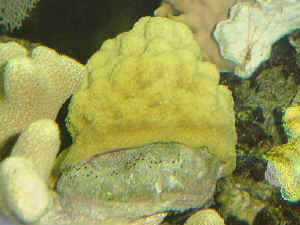 |
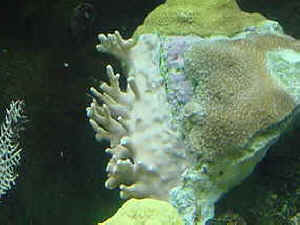 |
|
|

